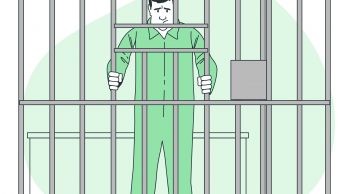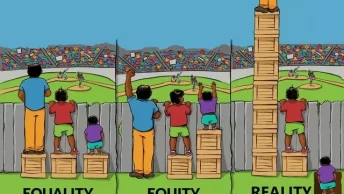India’s new trafficking bill relies exclusively on the stick to achieve its goals. It will fail.
Smt Maneka Gandhi, the Indian minister for women & child development, is likely to table ‘The Trafficking of Persons (Prevention, Protection and Rehabilitation) Bill 2018’ (hereafter, the bill) in the monsoon session of parliament scheduled to take place be-tween 18 July and 18 August 2018. The minister’s aspiration to make India a leader among South Asian countries to combat trafficking is laudable. Sadly, the tabled bill will, if enacted, fall far short of these expectations.
Many civil society organisations have already expressed their concerns regarding the serious shortcomings of the bill. My critique seeks to complement these other interventions by offering a commentary on the criminal law provisions of the proposed bill. Parliament must fundamentally rethink the bill to produce a well-drafted, rights-positive legislation that positions India at the forefront of the quest to achieve sustainable development goal 8.7 by ending forced labour, modern slavery, human trafficking and the worst forms of child labour.
Building out the reforms introduced in 2013
The proposed bill seeks to build on section 370 of the Indian Penal Code, 1860 (the IPC), which was amended in 2013 to include the stand-alone offence of trafficking.
Section 370 reads as follows:
(1) Whoever, for the purpose of exploitation, (a) recruits, (b) transports, (c) harbours, (d) transfers, or (e) receives, a person or persons, by—
First.— using threats, or
Secondly.— using force, or any other form of coercion, or
Thirdly.— by abduction, or
Fourthly.— by practising fraud, or deception, or
Fifthly.— by abuse of power, or
Sixthly.— by inducement, including the giving or receiving of payments or benefits, in order to achieve the consent of any person having control over the person recruited, transported, harboured, transferred or received, commits the offence of trafficking.
Explanation 1.— The expression “exploitation” shall include any act of physical exploitation or any form of sexual exploitation, slavery or practices similar to slavery, servitude, or the forced removal of organs.
Explanation 2.— The consent of the victim is immaterial in determination of the offence of trafficking.
(2) Whoever commits the offence of trafficking shall be punished with rigorous imprisonment for a term which shall not be less than seven years, but which may extend to ten years, and shall also be liable to fine.
In comparison to the international definition of trafficking housed in article 3 of the UN Protocol to Prevent, Suppress and Punish Trafficking in Persons, especially Women and Children (the Palermo Protocol), section 370 deleted a means of trafficking, namely, “abuse of a position of vulnerability” as well as a form of exploitation namely, “forced labour”. The Palermo Protocol also clarifies that the consent of a victim who is subject to any of the means listed in article 3 is irrelevant, whereas section 370 features a blanket denial of the consent of the victim – even if she/he has voluntarily decided to work under exploitative conditions. Section 370A, also introduced into the IPC in 2013 relates to use of a trafficked victim for sexual exploitation.
How has Section 370 been used since its passage in 2013? In research conducted by myself, Neenu Suresh (Centre for Labour Studies, National Law School of India University, Bangalore) and Hrishika Jain (NLSIU) we analysed a total of 125 appellate cases between April 2013 and July 2018 which showed that section 370 is often invoked in conjunction with various other legislation. The break-up is as follows: The Immoral Traffic (Prevention) Act, 1956 (32); The Bonded Labour System (Abolition) Act, 1976 (8); The Child Labour (Prohibition and Regulation) Act, 1986 (8); IPC Provisions on Rape, Sexual harassment and Outraging modesty (22); The Protection of Children from Sexual Offenses Act, 2012 (27); Juvenile Justice (Care and Protection Of Children) Act, 2000 (23) and other provisions (69).
Some of the cases relate to sex work but a few also deal with the exploitation of work-ers in other sectors, such as brick kilns, leather factories, domestic work, and Indian migrants to other countries (e.g. Malaysia). Appellate court judges have so far typical-ly dealt with section 370 in a procedural context; there has been little elaboration of the substantive provisions of the law. Interestingly, section 370 is used extensively be-yond trafficking cases. It often appears as an additional charge in criminal law cases relating to rape and sexual harassment, as well as in completely unrelated cases such as where a wife left her husband and took her child to live with another man. Section 370 is frequently used as a proxy offence for wrongful confinement. Exploitation for the purposes of section 370 is thus understood rather broadly. The true scope and ap-plication of section 370 is therefore dynamic.
Additionally, there has been little substantive elaboration of Section 370A. The High Court of Andhra Pradesh (S. Naveen Kumar versus The State of Telangana. 2015 (2) ALD(Crl.) 156(AP)) has held that a customer of a sex worker could be charge-sheeted under Section 370A. The High Court of Gujarat has however clarified that this is dependant on whether the relevant facts are proved through investigation (Vinod vs. State of Gujarat and Ors, Criminal Misc. Application (For Quashing & Set Aside FIR/Order) No. 8156 of 2017). Section 370A thus has the potential for being used to target customers of all sex workers whether trafficked or not.
What does the 2018 Trafficking Bill do?
The proposed bill builds on section 370 by creating an offence of “aggravated trafficking”, which criminalises:
- Trafficking for the purpose of forced labour or bonded labour (section 31(i));
- Trafficking for the purpose of bearing child (section 31(ii));
- Giving narcotic drug or psychotropic substance, or alcohol, for the purpose of trafficking (section 31(iii));
- Administering chemical substance or hormones to a person for the purpose of early sexual maturity and exploitation (section 31(iv));
- Trafficking of woman/child for the purpose of marriage or after marriage (section 31(v));
- Trafficking causing serious injury amounting to grievous hurt or death of the victim including suicide (section 31(vi));
- Trafficking of a pregnant woman or resulting into pregnancy (section 31(vii));
- Trafficking causing life-threatening illness, including HIV/AIDS (section 31(viii));
- Trafficking for the purpose of begging (section 31(ix));
- Trafficking of person suffering from mental illness or disability, or causing thereof (section 31(x)); and
- Trafficking by encouraging/abetting illegal migration into India/of Indians abroad (section 31 (xi))
Aggravated trafficking is punishable with (i) rigorous imprisonment for not less than 10 years and extendable to life imprisonment and (ii) liable to a fine of no less than 1 lakh rupees (Section 32). The bill also creates a range of other offences both related to and unrelated to trafficking which are discussed below.
Critique: lacks harmony with previous law
Although the bill seeks to expand the remit of section 370 to several sectors, including any work involving forced labour and bonded labour, it is silent on its relationship with various laws dealing with bonded labour, contract labour, inter-state migrant work, and sex work. Section 59 declares that this bill is in addition to existing laws and that in case of inconsistency it overrides the operation of other laws. In practice this will raise many problems.
For example, section 31(i) criminalises trafficking for purposes of forced labour and bonded labour by listing out several means through which trafficking is achieved: violence, intimidation, inducement, promise of payment of money, deception, coercion, or use of subtle means. Several of these means are already present in section 370 (threat, force, coercion, abduction, fraud, deception, abuse of power, inducement) so the list of means in section 31(i) seems redundant. Earlier drafts of the bill listed an element relating to exploitation in this offence (i.e. with or without payment of wages, or with payment of wages less than minimum wages; which reflects the Supreme Court’s views on forced labour in People’s Union for Democratic Rights v Union of India (1982) 3 SCC 235). This has been removed from the bill possibly to avoid the prosecution of employers for the ‘mere’ non-payment of minimum wages.
Multiplicity of legal regimes: For example, consider the case of trafficking for sex work. Section 5 of the Immoral Trafficking Prevention Act, 1986 (ITPA) criminalises procuring for purposes of prostitution with or without the consent of the victim. The punishment under section 5 is between three and seven years in prison with a fine of up to Rs. 2000. Section 370 of the IPC meanwhile lists several means necessary for the conduct of trafficking but also states that the consent of the victim is irrelevant. Trafficking for purposes of sexual exploitation under section 370 attracts a punishment of a minimum of seven years. Where a person has trafficked a sex worker, it is unclear which law the police will in fact use. The bill aims to harmonise laws relating to trafficking but does not in fact offer any guidance on the crucial area of trafficking for sex work.
Inappropriate gradation of offences: For example, section 370 covers various forms of exploitation including “sexual exploitation” and “practices similar to slavery” (which under international law includes bonded labour). However while trafficking for sex work (a form of sexual exploitation) would attract a punishment of seven years under Section 370, trafficking for bonded labour is considered to be aggravated trafficking and attracts a much higher punishment of 10 years to life. Thus, the bill grades offences in an inconsistent manner.
Operational inconsistencies: Significantly, although on the face of it the bill includes trafficking for bonded labour and forced labour, the spirit of the labour law approach found in addressing extreme exploitation in the Bonded Labour System (Abolition) Act, 1976 (BLSAA) is entirely missing. The bill relies heavily on the police at the central, state and local levels. Whereas earlier drafts of the bill provided for a bonded labourer to be brought before the labour officer or the district magistrate upon rescue, the bill now entirely relies on the police and magistrate’s court. Victims are sent to existing shelter homes, which can be designated as protection and rehabilitation homes under the bill. The BLSAA, on the other hand, emphasises the agency of the bonded labourer and requires the state to promote his or her economic independence through access to credit ensured by the district administration and vigilance committees rather than send him/her to a rehabilitation home. The carceral approach of the bill is thus a far cry from the administrative and labour law-oriented provisions of laws on bonded labour, contract labour and inter-state migrant work. Importantly, it is unclear which law would apply to a bonded labourer – the BLSAA or the Trafficking Bill, 2018? Does section 59 of the bill mean that it will, indeed, override BLSAA?
Tied to sex work exceptionalism
Although the bill does not explicitly concern itself with sex work, several of its provisions are formed in the carceral mould of the ITPA and are applied mindlessly to trafficking into other labour sectors. Take, for instance, the sections on keeping/allowing premises to be used for trafficking (section 34) and closure of premises where used for trafficking (section 35). These mirror, word for word, section 3 and section 18 of the ITPA respectively.
Like in many common law jurisdictions, the sale of sex for money is legal in India under restricted circumstances. Courts have held that a woman practising sex work in a house that she owns, without public solicitation, is engaging in a lawful activity. The goal of the ITPA is to prevent the “exploitation of the prostitution of others”, hence it seeks to criminalise anyone other than the sex worker who benefits from her sex work. Thus sections 3 and 18 of the ITPA target landlords, owners, and lessors of property where sex work is carried out.
Such stringent provisions, if implemented, are likely to freeze entire areas of the economy.
The bill lifts the content of these sections and applies it to trafficking into other sectors where the nature of the work itself is unproblematic (such as sewing garments, construction work, agricultural work). This means that landlords, lessors and lessees of properties where workers are trafficked into these sectors are now sought to be penalised. The absence of a clear-cut definition of exploitation in Section 370 or the bill and the broad application of Section 370 evident in case law so far means that these stringent provisions, if implemented, are likely to freeze entire areas of the economy. Worse still, these provisions will be meaningless especially when work is conducted in the household (domestic work) or in farms (agricultural labour). How can these premises be shut down? How then can these provisions prevent labour trafficking?
Departure from core principles of criminalisation and lack of constitutional safeguards
The bill introduces numerous other offences (sections 33-45), which include:
- Trafficking of persons on more than one occasion (section 33);
- Promoting or facilitating trafficking of person (section 36);
- Attempt and preparatory offences (section 44); abetting offence (section 37); dereliction of duty (section 38);
- Buying and selling of person (section 39(1));
- Publishing electronically obscene photos/videos/solicit tourists which may lead to trafficking (section 39(2))
- Exploitation of trafficked persons (section 40);
- Committing trafficking with aid of media (section 41(1))
- Distribution of electronic/printed form of sexual exploitation/sexual abuse/rape for extortion/coercion (section 41(2))
- Disclosing identity of victims through the media (section 42)
The bill relies heavily on the criminal law without many of the substantive and procedural safeguards that are integral to criminal law systems around the world, particularly in a country with a written constitution and robust constitutional safeguards protecting the life and liberty of citizens.
New offences unrelated to trafficking: The offence under section 41(2) has nothing to do with trafficking and amounts to censorship, especially when the terms “sexual exploitation” and “sexual abuse” have not been defined in the bill or under Indian law more generally.
Vaguely worded offences with disproportionate sentencing: The offence under section 39(2) speaks of soliciting or publicising electronically the distribution of obscene photographs or providing materials or soliciting tourists which “may” lead to trafficking. While the exact nature of the activity sought to be targeted is unclear, the punishment of 5 years’ imprisonment is disproportionate for an act that “may” lead to trafficking.
Anti-slavery provision re-incorporated: The offence under section 39(1) reinstates the offence under the original section 370 of the IPC, which dealt with the buying or disposing of any person as a slave. It is not clear why this offence is necessary given that slavery (such as during the transatlantic slave trade) is not practised in India.
Reversal of burden of proof and introduction of absolute liability offences:Section 19 of the bill states that:
Where a person is prosecuted for committing or abetting or attempting to commit any offence under this Act in respect of a child or a woman or a person suffering from physical or mental disability, unless it is specified, the designated court shall presume that such person has committed or abetted or attempted to commit the offence, as the case may be, unless the contrary is proved.
A presumption as to a culpable state of mind was first introduced in section 35 of the Narcotic Drugs and Psychotropic Substances Act, 1985, ostensibly to assist prosecutorial efforts and secure improved rates of conviction. However, section 19 goes well beyond presuming a culpable state of mind to effectively presume the commission of the offence unless otherwise proved; in other words, the defendant is presumed guilty unless proven innocent! The prosecution does not have to prove either the actus reus or the mens rea for affixing criminal liability, thus introducing an absolute liability offence as the prosecution only needs to bring frame charges against the accused. Similar provisions are to be found in the Protection of Children from Sexual Offences Act, 2012 and in the Criminal Law Amendment Act, 2013 in relation to aggravated rape but are constitutionally suspect.
Introduction of strict liability offences: In sections 34 and 35 of the bill, relating to the punishment of those managing premises or the closure of premises where trafficking occurs, there is a dramatic reversal of burden of proof. Whereas in the original sections of the ITPA (sections 3 and 18), the defendant is required to act knowingly and therefore possess a culpable mental state, in sections 34 and 35 of the bill, defendants have to prove that they exercised due diligence in order to avoid being prosecuted. This places an enormous burden on property owners and managers to exercise due diligence and ascertain whether trafficking is occurring on their properties, which is impossible given that core elements of the offence of trafficking are left undefined both in the IPC and in the bill.
High levels of punishment and lack of clear sentencing policy: Offences under the bill are cognisable, non-bailable and punishable with high, often minimum, mandatory sentences including life imprisonment for the remainder of one’s natural life. The gradation of sentencing under the bill, when read in conjunction with section 370 is furthermore not logical. Under Section 370(3), trafficking more than one person attracts a punishment of 10 years to life imprisonment. Section 370(5) punishes trafficking of more than one minor with between 14 years and life imprisonment. Section 33 of the bill, meanwhile, punishes trafficking on more than one occasion with life imprisonment for the remainder of one’s natural life. Thus the sentencing levels have gone up considerably even between 2013 (when Section 370 was passed) and 2018.
Weak punishment for employers: Section 40 of the bill states that whoever hires or otherwise obtains possession or lets to hire a person for purposes of trafficking shall be punished with imprisonment for between three and five years with a fine of not less than one lakh rupees. While the section seeks to hold employers accountable, it is unclear why the punishment for the employer is substantially less than that awarded to a trafficker. Why this discrepancy? This is also inconsistent with the punishment awarded to those who might harbour (this could include an employer) a trafficked person for purposes of exploitation by using the means listed out in section 370; there the punishment is a minimum of seven years.
Violation of right to property: Property owners under sections 34 and 35 are required to obtain the permission of the magistrate before they can let out their properties again. Whereas in the ITPA (on which sections 34 and 35 are modelled) such requirements for permission are time bound to a year (three years where a child is found at the premises), there is no such time limit in the bill. This is constitutionally suspect as an infringement on a citizen’s right to enjoyment of his or her property.
Provisions relating to bail presume guilt rather than innocence: The provisions on bail are also problematic. While in earlier drafts of the bill, bail was to be denied to a habitual offender or where the victim was a child, section 52(b) now requires that bail not be given unless the special public prosecutor is given an opportunity to oppose the application AND that the court is satisfied that there are reasonable grounds for believing that the accused is not guilty of the offence and is not likely to commit the offence. The requirement to pre-judge the case at the bail stage itself at this high objective standard of reasonableness (“reasonable grounds”) reiterates the presumption of guilt rather than of innocence. Provisions relating to anticipatory bail are also not applicable to those offending under the bill.
Raid, rescue and rehabilitate: old wine in new bottles
The bill embraces a law and order approach to trafficking (Section 20 (vi)) and envis-ages an elaborate institutional set up for dealing with prevention, prosecution, inves-tigation, protection, rescue and rehabilitation as illustrated in figure 1. The bill re-quires the creation of broadly two different kinds of agencies, namely, investigative agencies and rehabilitation agencies. The investigative machinery includes the National Anti-Trafficking Bureau, State Police Nodal Officers, State Nodal Officers, Dis-trict Police Nodal Officers, Anti-Trafficking Police Officers and Anti-Trafficking Units. Prevention is a code word for high levels of surveillance and “vulnerability mapping” (Section 20 (vii)). Further, police officers can, on mere suspicion that someone is being trafficked, conduct a raid and rescue operation. Victims are to be brought before the magistrate or the child welfare committee (where the victim is a minor) to be referred to protection homes and rehabilitation homes.
Police officers can, on mere suspicion that someone is being trafficked, conduct a raid and rescue operation.
As many commentators have pointed out, the bill relies on a failed model of raids, rescue and rehabilitation. It envisages the creation of relief and rehabilitation agencies including the National Anti-Trafficking Relief and Rehabilitation Committee, State Anti-Trafficking Committees and District Anti-Trafficking Committees. Existing shelter homes may be designated as protection and rehabilitation homes under the bill.
Central to the enforcement of the bill is the District Anti-Trafficking Committee (DATC) which has broad powers and has a role in preventing trafficking, and in con-ducting raids, rescues and rehabilitation. In relation to prevention, one of its tasks is to “coordinate with other State Departments and Panchayati Raj institutions, to keep a check on children who drop out from schools and those children who are covered by various schemes and have stopped accessing the benefits of those schemes … and in-form such cases to the State Anti-Trafficking Committee” (Section 13(3)(iii)). The DATC is also required to engage in vulnerability mapping and produce action plans for the prevention of trafficking (Section 13(3)(v)). The DATC can assist in raid and rescue operations, provide interim relief, transfer victims to rehabilitation homes, arrange for the repatriation of bonded labourers within the country; it also has the final authority for disposing of cases for the care, protection, treatment and rehabilitation of victims. Unlike in earlier drafts, the DATC no longer has representatives from the labour department or the panchayati raj institutions, which is problematic given the broad mandate of the DATC to address trafficking and labour exploitation. Furthermore, there is extensive documentation of the abuses that occur in the shelter homes, so much so that even Ruchira Gupta, the head of the radical feminist group Apne Aap, has denounced this provision of the bill. Why then revert to failed shelter homes?

Figure 1. Authorities to be established under the new bill. Graphic by Prabha Kotiswaran. CC-BY-NC.
Victims are forgotten
Rollback on protection for victims: In previous drafts of the bill victims’ rights were robustly protected. For example, the rehabilitation fund was entitled to a budgetary allocation from the central government. The government was to bring out rules to ensure the accountability of the agencies in generating, disseminating and utilising funds from the rehabilitation fund. The DATC was required to visit protection and rehabilitation homes at least once a month. The victim could be reimbursed for travel to a trial. The victim was required to be given timely notice of trials; had the ability to summon production of materials from parties and be heard on matters relating to conviction, sentencing, and parole. Protection for the victim was to be reviewed periodically by the government and the government was required to take immediate action in respect of any complaint relating to harassment of the victim, witness or informant and pass appropriate orders on the very same day. Sadly, none of these provisions have been retained in the current bill.
Highly restrictive non-criminalisation clause that is contrary to the defence of duress under the Indian Penal Code, 1860:
Under earlier drafts of the bill, the victim was protected by a non-criminalisation clause under both criminal law and administrative law. The victim could not be arrested or charged criminally or administratively for offences mentioned under the Foreigners Act, 1946, the Immigration Act, 1990 and the Passport Act, 1967.
Under the bill however, the victim is not to be held criminally liable only for serious offences (punishable with death, life imprisonment or imprisonment for 10 years) IF he/she committed or attempted the act under coercion/compulsion/intimidation/threat/undue influence AND where the victim has reasonable apprehension of death/grievous hurt/injury to himself/herself or a person he may be interested in.
The defence for the victim under the bill directly contradicts the current general de-fence of duress available under section 94 of the IPC. Under section 94, the defence is available for ALL offences except for murder and for offences against the state punish-able with death. Thus a victim of trafficking who is guilty of committing murder under circumstances of coercion would have a defence under the bill but not under Section 94.
The defence under section 45 of the bill is also narrower than under the IPC. Where section 45 of the bill offers a defence only for serious offences, the IPC’s general de-fence of duress only excludes murder and offences against the state punishable with death.
Both under section 45 of the bill and section 94 of the IPC, the duress has to result from some form of coercion, which causes reasonable apprehension of death/injury. This is an objective test. It is not necessarily how the victim himself perceives the threat but whether the threat can objectively be thought of as producing a reasonable apprehension. At the same time, the defence under section 45 is broader than the defence under section 94, in that the threat of grievous hurt and injury to the victim and someone he is interested in are also covered whereas to avail of the defence under Section 94, the defendant alone must apprehend instant death.
This bill’s provisions are very unfortunate because the anti-criminalisation clause is a hallmark of all progressive anti-trafficking laws around the world. The dilution of pro-victim provisions in subsequent drafts of the bill demonstrates the lip-service that the government is paying to victims of trafficking.
Bill in antithetical to the sustainable development goals
The bill exemplifies a deep dissonance within the government on the question of trafficking. The federal agency responsible for implementation of sustainable development goal 8.7 against trafficking, Niti Aayog, has been highly critical of the ILO-Walk Free Foundation Global Estimates on Modern Slavery (2017) and suspicious of sweeping figures relating to the prevalence of modern slavery and forced marriage particularly in the developing world. The Ministry for Women and Child Development, on the other hand, is influenced by Indian neo-abolitionist groups. These align with Walk Free Foundation’s reliance on a highly carceral approach to eradicating what is essentially a problem of deep socio-economic inequality.
This dissonance must be managed as India charts out how it can meet the SDGs, including by setting up suitable empirical baselines and benchmarks. So far, the Government of India has focused predominantly on SDG 8 rather than on SDG 8.7. Perhaps it assumes that where economic growth and the creation of jobs are ensured, trafficking, forced labour and modern slavery will be inevitably eradicated.
States which have been tasked with proposing action plans for achieving the SDGs are similarly selective in whether they deal with SDG 8 or not. Where they deal with SDG 8, they are selective about which parts of the goal they deal with. Some deal with SDG 8.7 and other don’t. Even states that deal with SDG 8.7 have varied understandings of the underlying problem and how they propose to address it.
Greater clarity on SDG 8.7 and, within that context, creative and effective strategies of dealing with trafficking, forced labour and modern slavery are essential. India might consider enacting a supply chain transparency clause, which has been enacted by the UK, the state of California and France and is under consideration in Switzerland and Australia. Paying attention to the full range of labour exploitation across the economy, including in international and domestic supply chains would be preferable to relying on a criminal justice system that appears tough on the face of it but which instead relies on failed models and institutions.
Prabha Kotiswaran lectures in Criminal Law at King’s College London. She is the author of Dangerous Sex, Invisible Labor: Sex Work and the Law in India, published by Princeton University Press (2011) and co-published by Oxford University Press, India (2011). She also blogs for the Interdisciplinary Project on Human Trafficking.
A slightly different version of the piece was first published in the Beyond Trafficking and Slavery Blog. This post has updated the case statistics for Section 370 IPC.








Your point of view caught my eye and was very interesting. Thanks. I have a question for you.